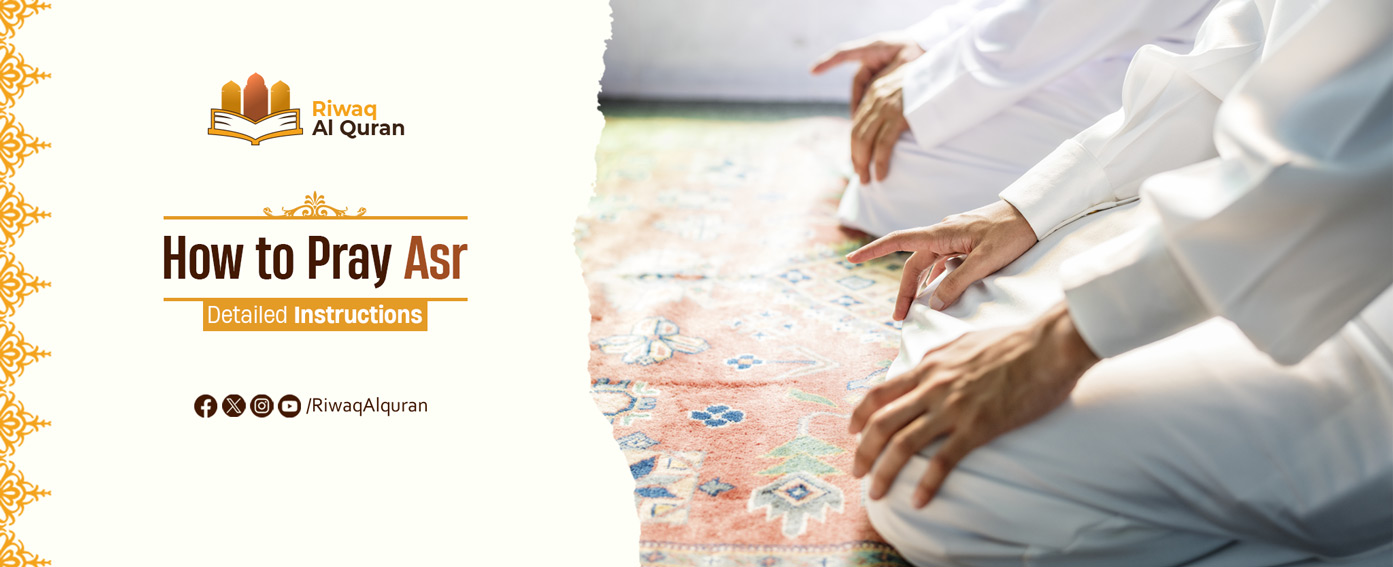Asr prayer, the third of the five daily prayers in Islam (Obligatory prayers are a vital component of Islamic life and the second pillar of Islam), is a very important prayer. It’s a midday time for meditation and spiritual growth. You will learn about the components, significance, asr prayer rakat, and fundamentals of Asr prayer from this tutorial.
Renew your intention to learn how to perform Asr namaz and keep reading!
Table of Contents
What Is Asr Prayer?
Asr prayer is one of the five compulsory daily prayers that every Muslim should perform. It is available in the afternoon, beginning just before sunset and ending when an object’s shadow is equal to its height.
When Is The Time Of Asr Prayer?
‘Asr prayer is known as The afternoon prayer, which refers to the time when the duration of Zhuhr ends and the length of an object’s shadow equals the length of the thing itself, that is when the time for ‘Asr begins.
Furthermore, the Asr time lasts until the sun turns yellow (I.e. the beginning of the sun setting).
How Many Rakats Is Asr?
There are four mandatory (Fard) rakats in the Asr prayer. This in addition to four voluntary rakats (sunnah) should be offered before the obligatory rakats of the Asr prayer.


Why Is Asr So Important?
Many hadiths highlight the value of the afternoon prayer, emphasizing the necessity of offering it on time and warning against neglecting it. For instance:
1. Allah says in the Quran:
“They are those who are punctual in the performance of their Prayer.”
2. Allah’s Messenger (PBUH) said,
“Whoever misses the `Asr prayer (intentionally) then it is as if he lost his family”.
3. Abu Musa reported that: the Messenger of Allah (PBUH) said,
“He who observes Al-Bardan (i.e., Fajr and `Asr prayers) will enter Jannah. ”
4. Abu Zuhair ‘Umarah Ruwaibah who heard the Prophet Muhammad (S.W.A) say that whoever performs salat before sunrise and sunset will not enter Hell.

How To Perform Asr Prayer?
Asr prayer is one of the five compulsory prayers, and its afternoon hour has many advantages.
To offer the Asr prayer, make wudu (ablution) and declare your purpose (niyyah). Raise your hands, stand and face the Qibla, and say “Allahu Akbar.”
Recite two Surahs, one of which is Al-Fatihah. Then perform bow (Ruku), and recite “Subhana Rabbiyal Azeem” three times, rise up, and prostrate (sujood) twice, repeating “Subhana Rabbiyal A’la” three times.
Continue in this way for the second rak’ah, and then sit down to recite the middle Tashahhud. Finally, complete two more rak’ahs, reciting only Surah Al-Fatihah, and finish with the full quote of Tashahhud, then do Tasleem, turning your head to the right and left saying “Assalamu alaikum wa rahmatullah.”
Thus, let’s get ready to learn how to pray ASR in the congregation and to be well-prepared for this unique rewarded prayer:
1. Gear Up For Asr prayer
Prepare yourself mentally and physically to enter Asr prayer to get the full rewards. Check the next points to know more:
Make Your Intention (Niyyat)
While you performing wudu or before you start Asr prayer, silently declare in your heart what you want (niyyah).
Renew Your Wudu (Ablution)
Making wudu before salah prepares your spirit and makes you feel excited and purified, regardless of whether you are currently in a state of wudu or need to renew it.
This will encourage you to attend salah as soon as possible, so you can feel the calm and refreshing sensation while being in Allah’s presence.
Wudu is a fundamental ritual in Islam. Whether it’s your first time performing wudu or you want to confirm your usual steps, refer to the guide below to learn all about the process:
Wudu Steps: How To Perform Wudu?
2. Stand And Face The Kaaba
Facing the Qiblah is one of the obligatory parts of the salah pillar that you must follow to ensure the acceptance of your prayer. Make sure to use the compass if you pray in an unfamiliar place.
Facing the Qiblah (direction of the Kaaba in Mecca) is a fundamental requirement for prayer, ensuring alignment with the unity of Muslim worshippers worldwide. Before beginning, stand upright with focus and humility, ensuring you are correctly oriented.
If you are in an unfamiliar location, use a compass, prayer app, or mosque indicators to find the accurate direction. Properly facing the Qiblah symbolizes devotion and obedience to Allah, reinforcing the spiritual significance of the prayer.
3. Start With The First Raka’h In the Asr prayer
The Isha prayer’s first rakat consists of multiple steps repeated in the subsequent three rakats, so be mindful of each one.
Starting with the first raka’h of Asr namaz, center yourself in the standing position. Say “Allahu Akbar” while you’re raising your hands to your earlobes, then follow the next steps:
Recite Surah Al-Fatihah And A Passage From The Quran
Fold your hands over your chest as the right hand should be on the top, Spell out silently Surah Al-Fatihah, then continue with short surah or what you memorize from the holy Quran.
Do you know The Easiest Quran Surahs to Memorize For Salah? Check it now.
Enter Ruku (Bowing Position)
Once you end up with the Quran recitation, raise your hands again in the Takbeer position, bow down, place both hands on your knees, and repeat silently Ruku’s dua “Subhana Rabbiyal Azeem” (Glory to my Lord, the Most Great)” three times.
Back To I’tidal Position
When you stand up from the bowing position, say the Takbir phrase “Allahu Akbar” while raising your hands to your ears.
After that, chant the I’tidal dua, which is “Sami’Allahu liman hamidah, Rabbana lakal hamd,” in silence.
Perform The First Sujood (Prostration)
Go from the I’tidal to the Sujud positions. Kneeling down to the point where your nose and forehead meet the floor and place your palms on the ground.
Say the Sujud dua three times in silence, beginning with “Subhana Rabbiyal A’la” (Glory to my Lord, the Most High).
With your hands on your knees and your body stretched back, conduct the Jalsa posture, and repeat its due by saying “Rabbighfirli,” which means “Oh Allah, forgive me.”
Move Into The Second Sujood
Recite “Allahu Akbar”, resuming your prostration, then repeat “Subhana Rabbiyal A’la” (Glory to my Lord, the Highest) three times in silence.
Once more, take a seat between two sujoods, and spell out “Rabbighfirli” (Oh Allah, please pardon me).

4. Head To The Second Raka’h In the Asr prayer
For the second rak’ah, follow the same steps as the first raka’h. Observe the acts listed below:
Return To Qiyam (Standing Position)
Raise your body to the standing position, say “Allahu Akbar” while you’re putting your hands in parallel with your earlobes, then recite surat al Fatiha and another short surah from the holy Quran.
Replicate the other steps from Ruku, I’tidal, Sujud, and the Jasla between two sujoods.
Recite First Tashahhud
In the Jalsa after the second sujud, point your index of the right hand toward, and say:
“At-tahiyyatu Lillahi wa-salawatu wa’t-tayyibat, as-salamu ‘alayka ayyuhan-Nabiyyu wa rahmat-Allahi wa barakatuh. As-salamu ‘alayna wa ‘ala ‘ibad-Illah is-saliheen. ashhadu alla ilaha illallah wa ashhadu anna muhammadan ‘abduhu wa rasuluhu.”
Which means:
{All dominion and greatness are for Allah, and all the prayers and all good speech and action are for Him. Peace be upon you O Prophet, and likewise the Mercy of Allah and His Blessings. And peace be upon us, and upon the pious servants of Allah. I testify that none has the right to be worshiped except Allah, and I testify that Muhammad is His servant and Messenger.}
5. Pray The Third And Fourth Raka’h In Asr Salah
Complete the first Tashahud, then continue with the next two Asr prayer rakats:
Execute The Last Two Rakats
Transfer to the last two rakats in the Asr prayer. Both follow the same procedures as the first rak’ah, except for the recitation. You should chant surat al Fatiha only without adding any additional passages from the Quran.
Read The Final Tashahhud
Practice all the previous procedures until you reach the Jasla position after the second sujood of the fourth raka’h. Repeat the same position as the first Tashahhud and say this time the full quote of Tashahhud:
“At-tahiyyatu Lillahi wa-salawatu wa’t-tayyibat, as-salamu ‘alayka ayyuhan-Nabiyyu wa rahmat-Allahi wa barakatuh. As-salamu ‘alayna wa ‘ala ‘ibad-Illah is-saliheen. ashhadu alla ilaha illallah wa ashhadu anna muhammadan ‘abduhu wa rasuluhu.
Allahumma salli ala Muhammadiw wa ala aali Muhammadin, kama sallayta ala Ibraheema wa alaa aali Ibraheema, innaKa Hameedum Majeed. Allahumma baarik ‘ala Muhammadiw wa alaa aali Muhammadin, kamaa baarakta ala Ibraheema wa alaa aali Ibraheema, innaKa Hameedum Majeed.”
Finalize The Prayer And Do Tasleem
Complete the last Tashahhud, place your index finger back against your knees, and repeat “Assalamu alaikum wa rahmatullah” as you turn your head to the right and then left to end the Asr prayer.

Experience Riwaq Al Quran Classes
Watch real moments from our live sessions at Riwaq Al Quran and see how we bring learning to life. These clips highlight our interactive, student-focused approach designed to keep learners engaged, motivated, and actively involved in every step of their educational journey.
Is It Allowed To Pray After Asr?
No, it’s forbidden to pray after Asr time until the sun has set. This is except for some prayers, such as the salat al-janazah (funeral prayer) or the Qada, which is the prayer for making up missing required prayers.
Additionally, You can derive this ruling from the following evidence in the Sunnah of the Prophet:
1. Narrated ‘Umar:
“The Prophet forbade praying after the Fajr prayer till the sun rises and after the ‘Asr prayer till the sun sets.”
2. Narrated Abu Huraira: Allah’s Apostle forbade two kinds of sales, two kinds of dresses, and two prayers. He forbade offering prayers after the Fajr prayer till the rising of the sun and after the ‘Asr prayer till its setting.
Is There Any Sunnah Before Asr?
Before the Asr prayer, it is recommended (mustahab) to offer two or four rakats of voluntary (Nafl) prayer, each two rakats with one Tasleem.
Narrated ‘Ali: That the Prophet (ﷺ) used to pray two rak’ahs before the ‘Asr prayer.


Why Students Love Learning with Riwaq Al Quran
Hear directly from our students about how Riwaq Al Quran Academy has transformed their connection with the Book of Allah. Their experiences reflect the dedication, care, and quality that guide every step of our teaching.
Learn Quran, Arabic And Islamic Studies Online With The Best Native Tutors
Riwaq Al Quran is a comprehensive online platform that offers personalized Quran, Arabic and Islamic Studies Online classes for individuals of all ages and backgrounds.
Their experienced instructors use a structured curriculum to cover Tajweed, Tafsir, and Memorization, providing easy and effective access to learning the Quran.
The advanced online classes allow for seamless communication and interaction between students and teachers. Join Riwaq Al Quran for a deeper connection with the Quran.
We offer several courses such as:
- Online courses for kids.
- Online Quran classes for kids and adults.
- Online Arabic courses
- Online Ijazah courses
- Online Islamic Studies courses.
Here are a sample of our set of Quran Courses that will be helpful for you:
- Online Tafseer Course: Delve into Quranic meanings with our insightful online Tafseer course.
- Noorani Qaida Online: Learn Quranic basics efficiently through our Noorani Qaida online program.
- Online Quran Recitation Course: Enhance Quranic recitation skills through our expert-led online course.
- Online Tajweed Classes: Master Tajweed rules for beautiful Quranic recitation in online classes.
- Quran Memorization Online Course: Memorize the Quran effectively with our specialized online memorization course.
- Online Qirat Course: Explore diverse Qirat styles with our comprehensive online Qirat course.
- Online Quran Classes for Kids: Nurture a love for the Quran in kids through interactive online classes.
Conclusion
The Asr prayer, the third of the five daily obligatory prayers, is performed in the afternoon, from when the shadow of an object equals its height until sunset. It consists of four mandatory rakats, with an additional four voluntary rakats recommended before the obligatory ones.
To perform Asr prayer, start with wudu, face the Qibla, and recite Surah Al-Fatihah followed by another short Surah. Bow and prostrate in each rak’ah, and conclude with the Tashahhud and Tasleem. It is prohibited to pray after Asr until sunset, except for specific prayers like Qada and Salat al-Janazah.
An essential part of a Muslim’s daily worship schedule is the Asr prayer. To conduct it properly, one must be aware of its importance, follow the directions for additional prayers during its time, and get the appropriate rakats. One can strengthen one’s connection with Allah and adhere to Islamic values by performing this prayer with sincerity and dedication.


































